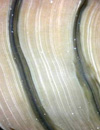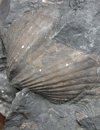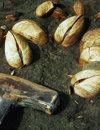
Paleogene Climate and Biotic Evolution of the US Gulf Coastal Plain
Visit full webpage. The Paleogene Period (65-25 million years ago) was a time of significant global climate change. The early Eocene represents a super-greenhouse world when the planet was largely devoid of glacial ice and high latitudes were remarkably warm. By the end of the epoch, climate had cooled to the point where a continental-scale ice sheet appeared on Antarctica. Integrated records of ecological and evolutionary change (based on fossils) and climate change (based on the geochemistry of those fossils) give insight into the various responses of organisms and ecosystems as their environment alters.
The US Gulf Coastal Plain provides an ideal setting within which to examine the ecological and evolutionary response of marine shelf faunas to changing climate. These sediments are characterized by the presence of rich and well-preserved shell beds throughout. Because preservation of original skeletal aragonite is common, an oxygen-isotope-based record of climate change can be refined and linked directly to the ecological response of faunas and the evolutionary response of their component taxa. As such, it is possible to track the in situ waxing and waning of diversity and shifts in composition and community structure within these faunas over the course of some of the most pronounced environmental changes of the Cenozoic.
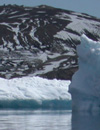
Eocene Climate and Biotic Evolution of Antarctica
Visit full webpage. The climate transition from the warm, equable world of the early Eocene to one in which continent-scale ice sheets blanketed the poles is reasonably well-known from sediments preserved at low and mid-latitudes, but little is known about the timing and magnitude of cooling on Antarctica, mostly because potential sedimentary archives are now covered by ice and inaccessible. One place on the continent contains a reasonably complete record of much of the Eocene in outcrop – the strata exposed on Seymour Island, off the coast of the Antarctic Peninsula. My colleagues and I collected fossil shells throughout the section to look at faunal change and used their stable isotope values to construct a record of climate through the Eocene. The data show that Antarctica experienced a shift toward cooler conditions ~41 million years ago, in concert with a proposed change in ocean circulation resulting from the opening of a marine gateway between Antarctica and South America. Cooling is associated with a notable change in the Antarctic biota, both on land and in the sea – a number of species become extinct and ecological changes suggest limitation by cold temperatures and/or low productivity.
 Permian Climate and Seawater Composition using the Chemistry of Fossils
Permian Climate and Seawater Composition using the Chemistry of Fossils
Visit full webpage. Paleoclimate work in Earth’s deep past has been limited by uncertainty about the meaning of unexpectedly low δ18O values from ancient marine carbonates. Increasingly negative values with increasing age could indicate very warm depositional temperatures, more negative seawater compositions, or pervasive alteration of the original carbonate. A significant impediment to progress has been the inability to convincingly demonstrate that the oxygen isotope values of carbonate retain their primary signal of depositional conditions. High-resolution microsampling of accretionary shell carbonate may offer a resolution to this aspect of the debate. Shells that demonstrate seasonal variation in isotope values along the growth trajectory can be more reliably interpreted as primary.
Micromilled data from the early Permian high-latitude bivalve Eurydesma from SE Australia show clear and consistent seasonal variation over 5-6 years of shell growth, suggesting primary compositions. Independent temperature control from associated glaciomarine sediments and glendonites require winter temperatures near freezing and therefore allow for determination of seawater δ18O. Shells arrayed over 11° of paleolatitude illustrate a trend toward more negative winter shell values and generally decreasing seasonal amplitude of water temperature moving toward the pole. Isotope data suggest seawater values decreased from -3 to -5 per mil with increasing latitude, significantly more negative than modern open marine values. This implies a much steeper gradient in the composition of seawater with latitude than today, mixing of depleted meltwater, and/or an overall more depleted ocean than today. Additional sampling to increase geographic coverage will help discriminate among these possibilities.
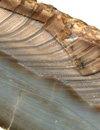
Stable Isotopes and Accretionary Skeletons: Paleoseasonality
Visit full webpage. Accretionary biogenic carbonates, such as the shells of fossil mollusks, offer an opportunity to recover information about seasonality in Earth’s deep past. High-resolution sampling and isotope analysis along the growth history of an organism can yield a detailed a record of the temperatures experienced by an individual throughout some portion of its lifetime. Capturing a number of years within a particular stratigraphic horizon yields not only a robust measure of seasonal temperature range for that habitat, but also information about inter-annual variability. With adequate coverage, both of these variables can be examined in a temporal or geographic context to see how they relate to change in mean annual temperature. The approach is not without its challenges – sampling resolution can smear the seasonal signal, organisms do not necessarily accrete carbonate throughout the year, and the depth at which benthic aquatic organisms live correlates roughly with the seasonal range they experience. Nevertheless, with a bit of care, these kinds of data can offer new insights on the climate system and the anticipated consequences of global change.
Stable Isotopes and Accretionary Skeletons: Growth and Life History
Visit full webpage. High-resolution microsampled records of stable isotope variation along the growth trajectory of a shell can reveal much about the life histories of ancient organisms and the environments in which they lived, allowing for study of longevity and growth rate through time. Data such as these can contribute to evolutionary studies of heterochrony and shed light on the environmental correlates of growth and longevity.
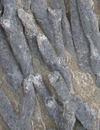
Influence of Outcrop Area on Measures of Phanerozic Diversity
Visit full webpage. Plotting the area of outcrop of sedimentary rocks against the recovered diversity of the same time interval reveals a strong correlation, demonstrating that the greater the area available for sampling, the more fossils and hence taxa are recovered. Even after standardizing for sampling intensity, the correlation persists, suggesting that the areal distribution of fossils needs to be taken into account in studies of Phanerozoic diversity. See papers by Wall and others (2009, 2011).
Coordinated Stasis and the Devonian Evolutionary Ecology of New York State
Visit full webpage. Long-term ecological and evolutionary stability is implied by our ability to recognize group-level differences in faunal composition in the stratigraphic record. The pattern of coordinated stasis is defined as long intervals of concurrent taxonomic and ecologic persistence separated by comparatively abrupt periods of biotic change, and was first described by Carl Brett and Gordon Baird based on marine faunas of the Silurian and Devonian of the Appalachian Basin. The fauna of the Middle Devonian Hamilton Group has been the type example, but discussion persists on just how stable the fauna is, and how best to assess it. Quantitative statistical analyses show that taxonomic and ecologic composition is more variable within stratigraphic horizons than between them, suggesting minimal net change through time in the assemblage. Observed stratigraphic distributions of fossils are consistent with a scenario in which all taxa are present from bottom to top of the unit, and absences result only from sampling failure. Extinction rate within the Hamilton Group is far lower than background levels for the Devonian. These results are consistent with the pattern of coordinated stasis. See Ivany et al. (2009), Brett et al. (2009).

